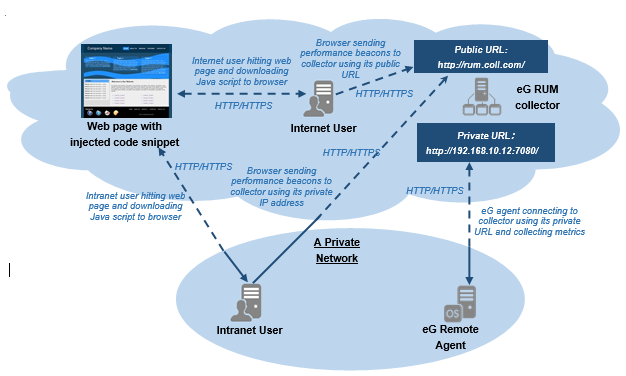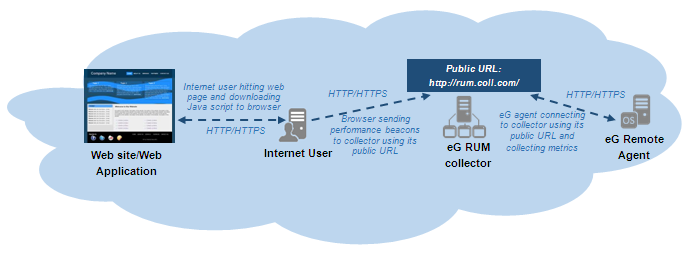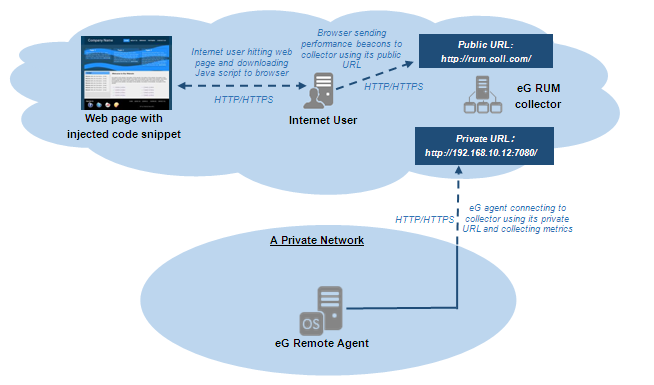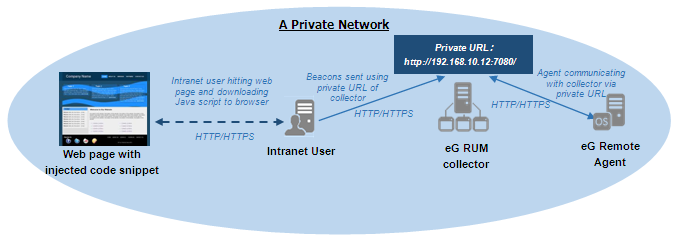Where to Install the eG RUM Collector?
Where the RUM collector should be deployed and how it communicates with the browsers and the eG remote agent depends upon the following factors:
- Where the users to the target web site/web application are coming from – i.e., where the browsers are;
- Where the eG remote agent is;
Note:
To ensure that the eG manager host is not overloaded, it is recommended that you do not install the collector on the same host as the eG manager.
If a web site/web application being monitored is being accessed by both internet and intranet users (see Figure 1), then the eG RUM collector can be hosted on the cloud. In this case, the eG RUM collector should be configured with both a private and public IP address. The browsers used by intranet and internet users will send the performance beacons to the collector via an HTTP/S connection to the collector’s public URL. On the other hand, if the remote agent has been deployed on a host in the intranet, then the agent will poll only the private URL of the collector (via HTTP/S) to collect metrics.

Figure 1 : A RUM collector deployment model where the target web application is accessed by both internet and intranet users and the eG agent is in a private network
If a web site/web application being monitored is being accessed by internet users only, then the collector should only be hosted on the cloud (see Figure 2). In this case, if the eG agent is also deployed on the cloud, it would suffice to configure the collector with a public IP address alone, as both the beacons and the agent will communicate only with the public URL of the collector, via HTTP/S.

Figure 2 : A RUM collector deployment model where both the target web application is used only by internet users and the eG agent is on the cloud
However, if in the above scenario, the eG agent alone is in a private network, then the collector should be configured with both a public and private IP address (see Figure 3). In this case therefore, the browsers will communicate metrics to the collector via an HTTP/S connection to its public URL, and the eG agent will communicate with the collector’s private URL to gather the metrics.

Figure 3 : A RUM collector deployment model where the web application is used only by internet users and the eG agent alone is in a private network
If the web site/web application is being used by intranet users only, the eG RUM collector should also be deployed in the intranet (see Figure 4). If the eG agent is also deployed in the same network, then both the browser and the eG agent can communicate with the collector using its private URL.

Figure 4 : A RUM collector deployment model where the target web application is used only by intranet users and the eG agent is also in the same intranet
However, if in the above scenario, the eG agent is in a different sub-net or on the cloud, then the collector will have to be configured with a public IP address alone (see Figure 5).

Figure 5 : A RUM collector deployment model where the target web application is accessed by intranet users and the eG agent is on the cloud
